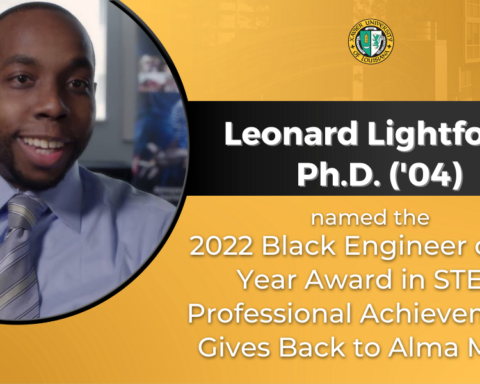- Written by Felecia M. Nave, Fred A. Bonner and Chance Lewis
Numerous reports assert that the United States must increase its production of highly educated workers in science, technology, engineering, and mathematics (STEM) fields in order to maintain its competitive edge in the global marketplace (Committee on Equal Opportunities in Science and Engineering 2004; National Science Foundation (NSF) 2006a, b; Southern Education Foundation, 2005). Historically Black Colleges and Universities (HBCUs) have an established and commendable record graduating African-American students in STEM fields. They are best suited to assist the United States in meeting its STEM workforce needs. According to the Thurgood Marshall College Fund’s latest demographic study, in 2006-2007, 23,531 students were pursing degrees in STEM at an HBCU, an increase of 57 percent over the last two decades (TMCF 8th Annual Public HBCU Demographic Study, 2011). An analysis of the Integrated Postsecondary Education Data System (IPEDS) (2004) revealed that nationwide HBCUs were the source of 22 percent of all bachelor’s degrees awarded to Blacks and 30 percent of the bachelor’s degrees awarded to Blacks in STEM fields (Perna, L., Lundy-Wagner, V., et.al 2008).
HBCUs continue to produce a disproportionate number of degrees awarded to African-American students in the STEM fields. Though only about 14 percent of African- American college students attend HBCUs, 40 percent of all African-American engineers received their degrees from these institutions. Similarly, of the top 21 undergraduate producers of African-American science Ph.D.s, 17 were HBCUs (U.S. Commission on Civil Rights Briefing Report). The accomplishments underscore the valiant strides that HBCUs have made and continue to make with African-American student populations despite the lack of pre-enrollment factors, i.e., high school preparation, grade point average, past course work in math and science (George, Neale, Van Horne, & Malcolm, 2001) and maintenance of interest (White, Altschuld, & Lee, 2007) that have been found to foreshadow success in STEM fields.
The state of STEM education in the United States is at best described as concerning and at worst dismal. A 2010 report submitted by the President’s Council of Advisors on Science and Technology (PCAST) revealed that STEM education in the U.S. will determine whether the country will remain a leader among nations of the world in solving complex global technological challenges. According to President Barack Obama, “The key to meeting these challenges—to improving our health and well-being, to harnessing clean energy, to protecting our security, and succeeding in the global economy—will be reaffirming and strengthening America’s role as the world’s engine of scientific discovery and technological innovation” (Jones, 2010, p. 35).
Current reports such as the National Academies Rising Above the Gathering Storm: Energizing and Employing America for a Brighter Economic Future highlight the rapid decline of the U.S. standing in STEM, particularly given the advanced standing that the country has occupied in these disciplines; namely, this document reveals that although the U.S. represents approximately 6 percent of the world’s population, it has produced more than 20 percent of the world’s doctorates in science and engineering. Additionally, worthy of note is the fact that 38 of the world’s 50 top research institutions, particularly in STEM, are located in the United States. Hence, an effort to maintain the relative standing of the country in STEM and STEM-related fields has to continue to serve as a national priority.
Perhaps the most vexing problem associated with the STEM conundrum is the lack of participation of populations of color in STEM postsecondary programs and ultimately in the STEM workforce. One group in particular, African-Americans, continues to be underrepresented. According to the American Society for Engineering Education (ASEE), 68 percent of all undergraduate engineering students in the U.S. are White, 14 percent are Asian-American, and just over 5 percent each are Hispanic and African-American (McSherry, 2005). Still other research by Anderson and Kim (2006) underscores the completion rates for African-Americans and Hispanics in STEM disciplines, indicating this rate to be 20 percent less than the rate for White students. In addition, Roach (2004) highlights combined graduation rates for African-Americans and Hispanics in engineering, lamenting the fact that this rate—listed at 11 percent— has not changed in a decade. The question related to these daunting statistics then becomes, how shall we go about addressing the underrepresentation of African- Americans in STEM?
Role and Function of HBCUs
The Historically Black College and University (HBCU) is a unique and important institutional type in the history of not only African-American higher education, but also higher education in general. According to Jennings, Bonner, Lewis, and Nave (2007), the HBCU has served as the primary vehicle in offering access to postsecondary education to African-Americans in the U.S. Roebuck and Murty (1993) define HBCUs as Black academic institutions that were established prior to 1964— the principle mission of these institutions was and continues to be the education of Black Americans. In the U.S. Commission on Civil Rights (2010) report titled The Educational Effectiveness of Historically Black Colleges and Universities, they report that “Currently, 103 HBCUs are located mainly in the Southeastern United States, the District of Columbia, and the Virgin Islands” (p. 1). Significant to the important role these institutions play is their enrollment of approximately 14 percent of all African-American students in higher education while constituting only 3 percent of the 4,084 total numbers of institutions existing in the country. Additionally, Brown (2002) reports HBCUs awarded 28.5 percent of all the baccalaureate degrees earned by African-Americans in 2001.
HBCUs continue to function in a variety of different roles; however, most noted is their functioning as the bridge to provide access to many students who would not be afforded the opportunity to attend an institution of higher education. Stewart, Wright, Perry, and Rankin (2008) state, “HBCUs remain the institutions that demonstrate the most effective ability to graduate African- American students who are poised to be competitive in the corporate, research, academic, governmental, and military arenas” (p. 28). As testament to this competitive edge, these authors go on to report that:
Nine of the top 10 colleges that graduate the most African-Americans who go on to earn Ph.D.’s are American public school teachers and 70 percent of African-American dentists earned degrees at HBCUs. UNCF members Spelman College (GA) and Bennett College (NC) produce over half of the nation’s African-American female doctorates in all science fields. HBCU Xavier University (LA) is ranked number one nationally in placing African-Americans into medical school (p. 28).
Thus, the place of the HBCU is firmly ensconced in the literature speaking to the education of African-Americans in the U.S. As Bonner and Murry (1998) stated, the picture of American higher education history would be woefully incomplete without the inclusion of the HBCU.
HBCUs and STEM Education
HBCUs play a significant role in the production of undergraduate degrees awarded to African-Americans in STEM. According to statistics reported by the National Science Foundation (2002), 30 percent of the undergraduate engineering degrees and 44 percent of the natural science undergraduate degrees were awarded to African- American students who attended HBCUs (pp. 4-10). Additionally, African-Americans undergraduates who completed their degrees at HBCUs were found to be more likely to attend graduate school as well as complete a doctoral degree. Extending this last finding and connecting it to the extant research on Black science and engineering matriculates, HBCUs were found to account for 17 percent of the Black graduate students in STEM (NSF, p. 30).
Capitalizing on the academic prowess of the best and brightest African-American students, those with an aptitude for science and mathematics will be important in reversing the tide of STEM underrepresentation. Again, it was the U.S. Commission on Civil Rights who reported that students at HBCUs had higher levels of academic involvement as well as critical opportunities to engage in research projects with faculty that ultimately contributed to their success. This report reifies findings by scholars (Bonner, 2001; Chubin, 2002; Chubin, May, & Babco, 2005; Maton & Hrabowski, 2005; Roach, 2004; Summers & Hrabowski, 2006) who have uncovered key factors that contribute to the academic success of African-American students in STEM.
Although speaking about not only the contributions to STEM, but African-American participation in general, Reynolds said to the Civil Rights Commission, “Twentyfour individual HBCUs graduate the same numbers of blacks as the University of Michigan and the University of North Carolina at Chapel Hill combined” (p. 21), He went on to state:
Morgan State University alone graduates almost as many black students as all of the Ivy League campuses taken together, and Southern University graduates even more. Howard University and Florida A&M graduate more blacks that the entire University of California System, the largest public university system in the nation (pp. 21-22).
Unquestionably these data reveal for the general African-American collegiate population, in general, and the STEM population, in particular, that HBCU serves as a crucible in which an elixir for success can be developed. The quintessential question that the HBCU is effectively answering is: How do we recruit, challenge, support, and graduate the best and brightest young African- American minds in STEM-related disciplines?
Clearly the impact that these institutions have made in producing the past cadre of scientists and the contemporary cohort of engineers is unquestioned. Beyond the supportive environment that the HBCU provided for students to fashion their academic and social development, a number of additional benefits were found to accrue to matriculates. For those who were excelling, they exhibit a natural curiosity and desire to learn more about STEM. This curiosity, coupled with a motivation to succeed despite any internal or external obstacles, creates the appropriate combination for their success. Additionally, the P-12 academic record significantly frames a STEM students’ academic progress. Specifically, the high school experience in the areas of mathematics and science separate the students who excel verses the students who struggle with a STEM curriculum. Adding to a comprehensive background in mathematics and science, a supportive postsecondary faculty member in the HBCU context solidified the student’s trajectory towards achievement. Not enough can be said about faculty who invest the time and energy in making certain that these students are successfully matriculating. The faculty not only model the behaviors indicative of STEM professionals but are also viewed as being critical in the “next steps” of the student’s journeys— whether that be the world of work or graduate and professional school. While it was evident that faculty play an important role—many of the students lament the lack of Black faculty among the ranks of the STEM professoriate. What is clear is that given the wide array of challenges and opportunities in the HBCU STEM environment, these institutions will continue to serve a major function in the advancement of African-American students in these fields.







